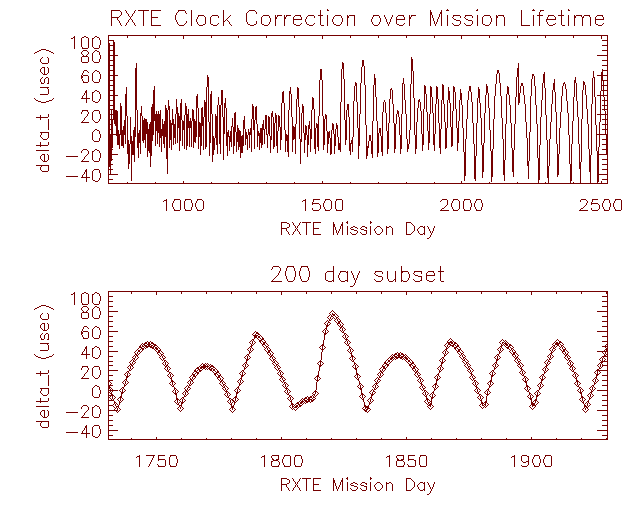The GOF's Top Tips on How to Have the Best Time!
IntroductionNOTE: The time stamps present in RXTE FITS tables as generated by XFF are in TT. As part of the HEAsoft5.04 patch (February 2001), the GOF released an improved tool for applying barycentric corrections: FAXBARY. The previous standard tool for applying these corrections, FXBARY, was based on inherited routines and on an ephemeris (de200_new.fits) that does not extend beyond December 31, 2000. FAXBARY uses the more accurate jplephe.200 ephemeris, extending to 2050. It also incorporates several fine clock corrections that FXBARY lacked, which improves the absolute time calibration from ~60 microsec to ~5-8 microsec.
Why Switch from FXBARY to FAXBARY? The short answer is that FAXBARY is much more accurate than its predecessor. Here's why:
(Note that FASEBIN has always included the fine clock corrections from the tdc.dat file.) DO's and DON'Ts and other helpful hints:An input list of orbit files is handled slightly differently by FAXBARY than by FXBARY. To use more than one orbit file, either enter them directly at the orbitfiles parameter prompt (as a whitespace-separated list) or use the typical ftools @filelist syntax, where "filelist" lists the orbit files one per line. Like FXBARY, FAXBARY will first examine all of the orbit files and reject any which do not overlap with the times in the datafile to be corrected. Note, however, that any list of orbit files MUST be continuous and not contain any gaps! If this criterion is not satisfied, the FAXBARY script will print an explanatory error message and exit. As with fxbary, the value of the TIMEZERO keyword applies to the BARYTIME column in the output file, thus the barycentric correction can be derived by simply taking the difference between the TIME and BARYTIME columns.
If you are comparing results across the 2000/2001 boundary, keep in mind that the new program is much more accurate than results from the old program. You may want to reanalyze everything with FAXBARY if you require consistent accuracy greater than 60 µs. The RXTE GOF pages provide guest observers with several helpful explanations of time systems, time stamps, and coversions. These include: If you have a question about RXTE, please send email to one of our help desks.
|



